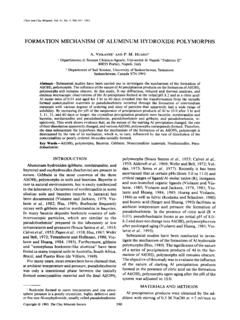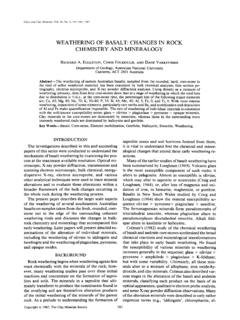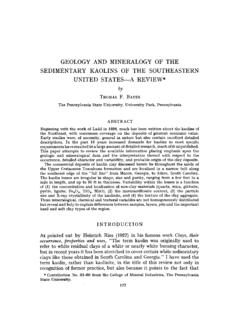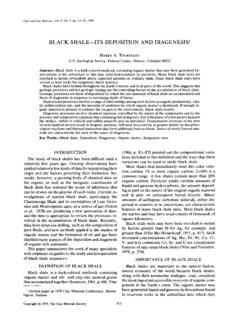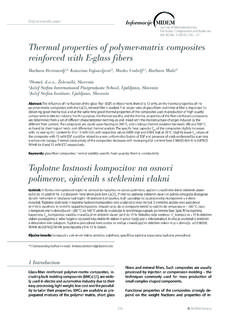Transcription of NOTE Clay-organic complexes - The Clay Minerals …
1 Clays and clay Minerals , 1972, Vol. 20, pp. 189-191. Pergamon Press. Printed in Great Britain NOTE Clay-organic complexes Clay-organic complexes -A SEMINAR REPORT A SEMINAR on Clay-organic complexes was held in Kyoto, Japan, August 24-27, under the auspices of the United States-Japan Cooperative Science Program, ad- ministered jointly by the National Science Foundation and the Japan Society for the Promotion of Science. A proposal from the Japanese side that a joint seminar might be of great interest was taken up with enthusiasm in both countries. In addition to the delegations from Japan and the United States, scientists from Germany and Taiwan also participated. E. Suito of Kyoto University and G. W. Brindley of the Pennsylvania State University acted as coordinators, with M.
2 Koizumi of Osaka University as secretary. Some 30 major papers and many smaller con- tributions were presented. Attention was given mainly to the naturally swelling Minerals , smectites and vermicul- ites, but reactions with kaolinite[6,22,26,30], paly- gorskite [21], imogolite[4], and calcium silicate[7] also were considered. The seminar was conducted mainly under four broad headings: structures, reactions, experi- mental methods, and applications. STRUCTURES The structures of Clay-organic complexes cannot usually be treated by the precise methods of three-dimen- 9 sional X-ray diffraction analysis [9, 13]; neither the miner- als nor the resulting complexes are sufficiently regular for this type of analysis, but one example (that of 6-amino- hexanoic acid vermiculite) was discussed in which suffi- cient order was obtained to permit conclusions to be drawn [10].
3 Generally a combination of techniques may lead to valuable results, particularly one-dimensional diffraction analysis combined with quantitative absorption data and absorption spectrometry[9, 14, 23]. The possibility of using high-resolution electron microscopy for direct observation of individual clay particles and their internal structure, including observations of dislocations and other possible imperfections[1 I, 131, and for the study of sur- face reactions (epitaxial processes)[12] was beautifully illustrated; lattice images of octadecylammonium mont- morillonite were shown. New data on the effect of tem- perature on long chain aliphatic complexes of montmoril- lonite were brought forward. It has been known that chain molecules can take up different orientations at tempera- tures above and below their normal melting points.]
4 The new data showed that kink formation occurred[15]; as the melting point was approached, the basal spacing de- creased in small steps, at the melting point a much larger decrease occurred, and above the melting point further small decreases took place. The detailed results were complex and montmorillonite with a very uniform charge 189 distribution was said to be necessary to observe these effects [15]. REACTIONS Reactions between clays and organic materials [3-7] was probably the major topic of the seminar, and spectroscopic analysis is the most widely applied tech- nique. From the pleochroism of critical vibration fre- quencies, the orientation of organic molecules relative to the silicate layer structure in favorable cases may be unequivocally determined[9, 14, 23]; this requires that the assignment of the frequencies be known and that the organic molecules take up clearly defined arrange- ments.
5 Spectral frequency shifts or absence of such shifts may indicate the presence or absence of interactions in- volving particular functional groups [3, 14]. Absorption of organic molecules as a result of protona- tion occurs in a variety of ways[3]. Cation exchange of inorganic by organic cations is well known. In partially exchanged systems, a segregation may occur of the two kinds of cations in different layers, with the formation of interstratified structures. Besides external protonation, internal protonation can occur by various mechanisms: (i) by H + ions occupying exchange sites, (ii) by dissociated water molecules associated with metal cations, (iii) by proton transfer from another cationic species already present. An acid clay surface is quite acidic and molecules such as amines, urea and amides are readily protonated within the layer structure.
6 Water, particularly in trace amounts in montmorillonites containing cations with high electric fields, may be highly dissociated and a proton may be donated to an organic molecule or may serve as a "bridge" between the cation and the organic molecule. When the amount of an absorbed base exceeds the pro, tons available for cation formation, the additional organic may be held as neutral molecules, or a strong symmetrical hydrogen bond of the type ( +.--B) may be formed. Another class of complex involves cation-dipole reac- tions between the inorganic cations and dipole groups of the molecules. A particularly interesting type of complex was described[3] between aromatic molecules (such as benzene and variously substituted benzenes) and Cu 2+ ions through the ~" electron system of the organic mole- cules.
7 The trimethylsilation of calcium hydrous silicates by the Lentz method (reaction with an organo-silicon com- pound such as hexamethyldisiloxane) was described us- ing bydrothermal reactions under conditions which would produce tobermorite gel, crystalline tobermorite or xonot- lite [7]. The nature of the products, linear or ladder-type polymers, was shown to depend on the crystalline state of the calcium silicate. 190 NOTE clay Minerals AS CATALYSTS The role of clay Minerals as catalysts in organic reac- tions was discussed in several papers. The possible role of clays as high surface area adsorbents in the synthesis of biochemically important molecules[18] in prebiotic earth history was discussed, and experiments were de- scribed in which the various steps in the sequence CO2 +N H3 ~ urea + H20 ~ amino acids ~ polypeptides + H20 had been studied.
8 The successful synthesis of sugars, cytosine and uracil from CO2 and NH3 in the presence of kaolinite was reported. clay Minerals act as template catalysts for esterification reactions of fatty acids in water to form glycerides. The synthesis of phospholipids using clays as catalysts also was described. This type of mech- anism for the formation of complex materials of the kind found in living systems was considered to be a challeng- ing alternative to syntheses in which radiation, ioniz- ing particles, or electric discharges are used as activating agents. Clays as catalysts in the genesis of petroleum hydro- carbons[19] was another topic of considerable interest. Chemical kinetic studies indicate that under the diagenetic conditions in sediments when montmorillonites are con- verting to illites, fatty acids associated with the mont- morillonite may be converted to long-chain paraffins, but not immediately to the association found in nature.
9 At greater depths further diagenesis may lead to cracking of the long-chain paraffins resulting in an association similar to that found naturally. A novel contribution considered the explosiveness of benzoylperoxide [20] mixed with bentonite in the presence of sulphurous acid and its possible application to smog control by spraying benzoylperoxide-silicate dusts over large towns having problems with sulphurous fumes. KAOLINITE complexes Surface activity and organic adsorption on kaolinite were the subjects of several papers. Adsorption isotherm studies with anhydrous butylamine show strong adsorp- tion in proportion to edge area with one BuNH2 molecule per silanol group, and it appears that the quantity ad- sorbed is twice as great from non-aqueous ( heptane) as from aqueous solutions [6].
10 If a hydrate molecule, BuNH2 9 H20 is adsorbed then steric hindrance may ex- plain the smaller adsorption from aqueous solutions. An- other contribution[22] compared the surface modifying effect of butanol on silica gel and on kaolinite. Silica gel becomes hydrophobic by the reaction --OH + C4 HgOH ~ --OC4H9 + H20. In the case of kaolinite a decrease in the heat of wetting on immersion in water is small, so that the silanol groups in kaolinite are considered to be less reactive. Halloysite, by contrast, appears to have a more reactive surface than kaolinite. EXPERIMENTAL METHODS Adsorption isotherms for organic compounds are used in a variety of ways for determining surface areas and sur- face charge and both external and internal areas can be probed [8].

